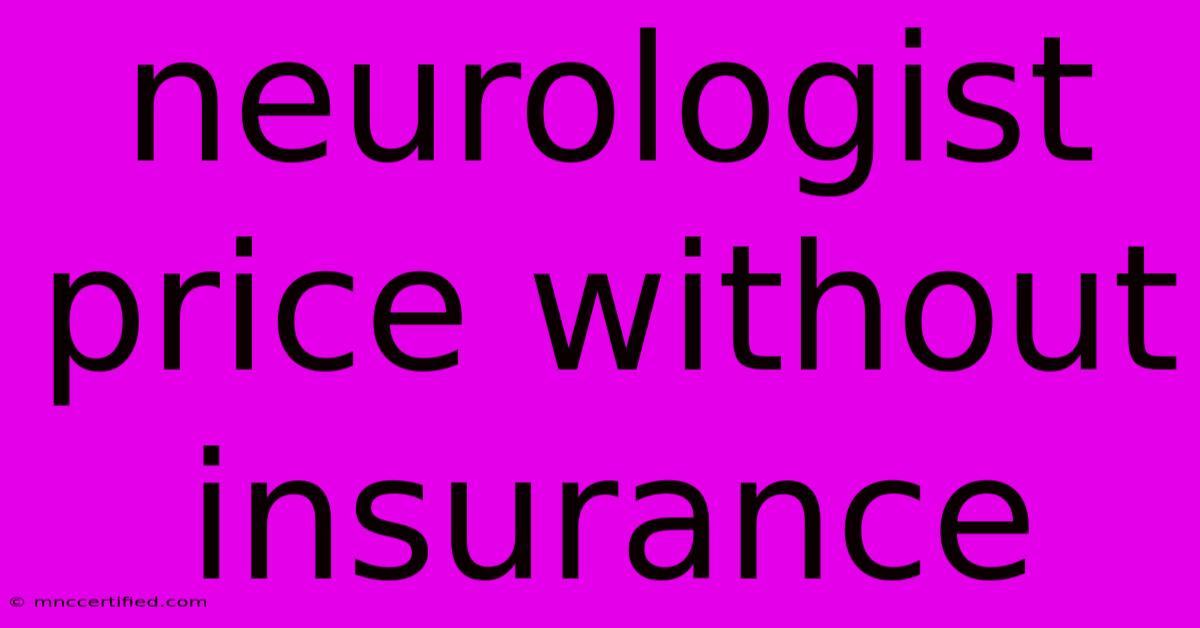Neurologist Price Without Insurance

Table of Contents
The Cost of Seeing a Neurologist: A Guide to Prices Without Insurance
Navigating the healthcare system can be challenging, especially when it comes to unexpected medical expenses. Seeing a neurologist, a specialist who diagnoses and treats disorders of the nervous system, can be a significant investment, particularly if you don't have health insurance. This guide will provide a comprehensive breakdown of neurologist prices without insurance, helping you understand what to expect and how to manage costs.
Factors Affecting Neurologist Prices
Several factors can influence the price of a neurologist visit without insurance:
- Location: Neurologist fees can vary greatly based on your geographic location. Metropolitan areas tend to have higher costs compared to rural regions.
- Type of Visit: Initial consultations, follow-up appointments, and specialized procedures like nerve conduction studies or electromyography (EMG) will have different price tags.
- Length of Visit: A longer appointment with a more complex evaluation will typically cost more.
- Specific Services: Additional testing, such as MRIs, CT scans, or spinal taps, will add to the overall cost.
Typical Costs of a Neurologist Visit Without Insurance
While prices can vary, here's a general estimate of what you can expect to pay:
- Initial Consultation: $200 - $400
- Follow-up Appointment: $100 - $250
- Nerve Conduction Studies: $500 - $1000
- Electromyography (EMG): $400 - $800
Remember: These are just estimates. It's always best to contact the neurologist's office directly to obtain accurate pricing information.
Managing Costs: Options for Uninsured Patients
Even without insurance, there are options to manage the cost of seeing a neurologist:
- Negotiate Payment Plans: Many neurologists offer payment plans to help patients afford treatment.
- Seek Out Discounted Care: Look for community health centers, free clinics, or non-profit organizations that may provide discounted neurologist services.
- Ask About Sliding Scale Fees: Some clinics offer sliding scale fees based on income, potentially reducing the cost of your visit.
- Consider Telemedicine: Telemedicine consultations, where you see a neurologist remotely, can sometimes be more affordable.
- Explore Financial Assistance Programs: Look into programs like the Patient Advocate Foundation or the National Organization for Rare Disorders (NORD) for financial assistance options.
Prevention and Early Detection: Key to Lowering Costs
While costs can be a concern, prioritizing your neurological health can potentially save you money in the long run. This involves:
- Regular Checkups: If you have any neurological concerns, don't hesitate to see a neurologist for an evaluation.
- Early Diagnosis: Early detection and treatment of neurological conditions can prevent complications and potentially reduce future costs.
Finding a Neurologist: Tips for Your Search
- Ask for Referrals: Talk to your primary care physician or trusted healthcare providers for recommendations.
- Research Online: Use online resources like Healthgrades or Vitals to find neurologists in your area and read patient reviews.
- Check for Board Certification: Ensure the neurologist is board certified to guarantee their qualifications and expertise.
Conclusion
Managing the cost of seeing a neurologist without insurance can be challenging, but it's important to remember that your health comes first. By understanding the factors that influence prices, exploring available options, and prioritizing prevention and early detection, you can make informed decisions and find affordable neurological care.

Thank you for visiting our website wich cover about Neurologist Price Without Insurance. We hope the information provided has been useful to you. Feel free to contact us if you have any questions or need further assistance. See you next time and dont miss to bookmark.
Featured Posts
-
Krispy Kreme Free Dozen World Doughnut Day Deal
Nov 14, 2024
-
Mid State Insurance Jacksonville Il
Nov 14, 2024
-
Megalopolis Streaming Find It Now Online
Nov 14, 2024
-
Veteran Actor Timothy West Dead At 90
Nov 14, 2024
-
What Is Tesla X Investment Platform
Nov 14, 2024